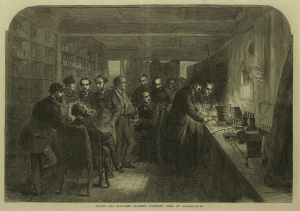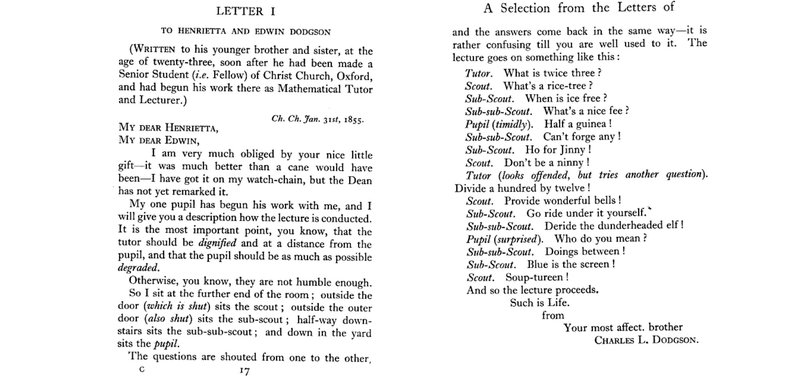Fearfully Funny: Making Sense of Nonsense
 Charles Dodgson (who later took the pen name Lewis
Carroll) entertained a flight of fancy about teaching. He embarked on his academic career by tutoring
a pupil at Christ Church, Oxford. He understood
the tutor-student relationship to be one where the distance required for
authority and deference should be maintained and suggested that it could be
represented in the form of the game traditionally known as ‘Whisper Down the
Lane’ or (in the sinophobic designation) ‘Chinese Whispers’. In a letter to his sister and brother in 1855
he set out the way a question and answer relayed between teacher and pupil
would become distorted if physical distance intervened between the tutor in an
upstairs room with closed door and the pupil humbly seated beyond another
closed door down below in the yard.[1] The message was to be relayed by those
personal servants known in Oxford University as ‘scouts’. A series of three were to be placed between tutor
and pupil. The fanciful scenario is
based on a literalisation of the idea of emotional and psychological
distance. When the tutor called out his
first and second questions “What is twice three?” and “Divide a hundred by
twelve” the scouts passed the message on.
Each in turn mis-hears. Comic
confusion followed as the pupil apparently accused the tutor of being a ninny
and the tutor apparently instructed the pupil to ‘deride the dunder-headed elf!’. Indignity, offence, bashfulness and alarm are
the emotions that paradoxically come into play in this system designed to
maintain dignity and subdue emotion.
Charles Dodgson (who later took the pen name Lewis
Carroll) entertained a flight of fancy about teaching. He embarked on his academic career by tutoring
a pupil at Christ Church, Oxford. He understood
the tutor-student relationship to be one where the distance required for
authority and deference should be maintained and suggested that it could be
represented in the form of the game traditionally known as ‘Whisper Down the
Lane’ or (in the sinophobic designation) ‘Chinese Whispers’. In a letter to his sister and brother in 1855
he set out the way a question and answer relayed between teacher and pupil
would become distorted if physical distance intervened between the tutor in an
upstairs room with closed door and the pupil humbly seated beyond another
closed door down below in the yard.[1] The message was to be relayed by those
personal servants known in Oxford University as ‘scouts’. A series of three were to be placed between tutor
and pupil. The fanciful scenario is
based on a literalisation of the idea of emotional and psychological
distance. When the tutor called out his
first and second questions “What is twice three?” and “Divide a hundred by
twelve” the scouts passed the message on.
Each in turn mis-hears. Comic
confusion followed as the pupil apparently accused the tutor of being a ninny
and the tutor apparently instructed the pupil to ‘deride the dunder-headed elf!’. Indignity, offence, bashfulness and alarm are
the emotions that paradoxically come into play in this system designed to
maintain dignity and subdue emotion.
In telegraphy distance is similarly challenging. 1,600 nautical miles had to be bridged by the transatlantic telegraph: the full distance from Ireland to Newfoundland. The communications errors that ensued bear comparison to the farcical miscommunication imagined by Dodgson. The failure of the cable did not always result in an immediate cessation of signal. As breaches in the line caused current to leak out and as electrolytic activity or temporary cladding of air bubbles temporarily resealed the cable, the signal wavered. The transmission of messages was subject to the ‘jumbling effects of earth currents – those vagrant telegraphic pests’ as James Burn Russell an assistant of the engineer William Thomson phrased it in 1858.[2] Characterised in this way (as vagrant pests) they play a role akin to that of the scouts and sub-scouts of Dodgson’s fancy.
- For a few days, fragments of messages were cast up now and again, the jetsam of the sea which was soaking into our poor cable. Here is a sample of these disjecta membra. “Spot is difficult, tell when you are sending. * * * Field to Directors * * * but should like to have something intelligible from you. * * * * it.”
- From broken sentences we descended to words. Soon even these ceased to cheer the eyes of the weary watchers, and only letters appeared, rari nantes in gurgito vasto; then came chaos.
Some electrical engineers, trying out various remedies for the faulty cable and convinced that their technical solutions were helping matters, sought to interpret fragmentary of words or letters that appeared at the receiving station. In this they were relaying the misheard just as Dodgson’s intermediate scouts sought to make sense of nonsense. J. B. Russell saw the funny side of this.
- First came Mr. Varley. His panacea was long doses of positive electricity, intended to form some imaginary compound of copper and alumina, succeeded by negative. It was amusing to witness his efforts to twist and squeeze sense from the invariable jumble, that the benefit of the nostrum might be demonstrated.
The affective regime of nonsense is not that of polite or chilly emotional distance but of absurd uncoupling, surprising substitution, alarming collisions and illicit conjunctions, generating fear as well as hilarity. The philosopher and cultural commentator Gilles Deleuze registers the grim world that Alice finds down the rabbit hole.
- In Lewis Carroll, everything begins with a horrible combat, the combat of depths: things explode or make us explode, boxes are too small for their contents, foods are toxic and poisonous, entrails are stretched, monsters grab at us. A little brother uses his little brother as bait. Bodies intermingle with one another, everything is mixed up in a kind of cannibalism that joins together food and excrement. Even words are eaten. This is the domain of the action and passion of bodies: things welded together into nondecomposable blocks. Everything in depth is horrible, everything is nonsense. [3]
Reading Carroll’s Alice’s Adventures in Wonderland (1865) and Through the Looking Glass, and What Alice Found There (1871) we recognise that the proprieties of emotional distance are ruled out by the leaps and errors of the distances traversed (like the distance from tutor’s office to yard, involving discontinuities, demanding relay). Alice herself cannot be aloof as she would like. The buffets and bewilderment cause her pangs. She is actually rather touchy.
I propose that we follow J. B. Russell in conceiving of the stuttering cable in physiological terms giving on to sensation and emotion. He produces a rather laboured metaphor to express his pious belief that telegraphy will banish warfare. The sentiment is a commonplace for the period but the imagery and language of his assertion are unusually intense. The passage comes right in the midst of his discussion of breaches in the cable and what he explicitly sees as the physician-like efforts of electrical engineers to restore the functioning of the cable. The cable is envisaged as a neural pathway in the body of the world.
- A man who has no feeling in his members may cut and mangle them without being immediately inconvenienced. When intercommunication is tedious, and fellow feeling dead, the members of the great trunk of humanity may hack and hew each other without at once or seriously disturbing the distant and general body. But quicken the nerves of the man, and he will shrink from a pin’s point. Spread under sea and over land the electric network, and the barbarity of a bayonet-stab will send a thrill throughout the great system.
He is referring to literal slashing and mangling on the battlefield, but due to the position of this passage we cannot help but think of the breaches in the cable as producing painful stabs into a neural system. The jumbled messages that are generated by slicing into the nerve/cable are agonisingly amusing, fearfully funny.
[1] Letter Charles Dodgson to Henrietta and Edwin Dodgson, 31st Jan 1855, in Evelyn M. Hatch (ed. intr. and notes), A Selection from the Letters of Lewis Carroll, London: Macmillan, 1933, pp. 17-18. This letter is quoted by Robin Wilson, Lewis Carroll in Numberland: His Fantastical Mathematical Logical Life, An Agony in Eight Fits, New York and London: Norton & Co, 2008, pp. 56-7.
[2] James Burn Russell, ‘Atlantic Cable: Leaves from the Journal of an Amateur Telegrapher’, The West of Scotland Magazine and Review, New Series. Glasgow. Published in three parts, in the issues of January, February, and July 1859. Consulted on website History of the Atlantic Cable & Undersea Communications from the first submarine cable of 1850 to the worldwide fiber optic network , http://atlantic-cable.com/Article/1858JBRussell/index.html consulted 31st Jan 2016. This item on the site has a very useful detailed bibliographic note by Bill Burns. The published diary differs from the unpublished manuscript diary Glasgow City Archives ( Mitchell Library) TD1434/1 which is partly transcribed (by Mary Burns) on the site. See Porthcurno Research blog 18 Feb 2011 by Allan Green on James Burn Russell (1837-1904) consulted 2nd Feb 2016. All subsequent quotations from this document refer to the 1859 text from The West of Scotland Magazine (unpaginated as it appears on the website History of the Atlantic Cable).
[3] Gilles Deleuze, ‘Lewis Carroll’, in Essays Critical and Clinical (1993)(translated by Daniel Smith and Michael Greco), London and New York: Verso, 1998, pp. 21-22.
